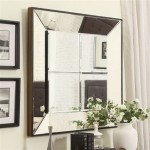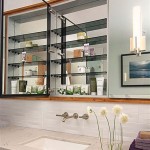How To Remove a Wall Mirror
Removing a wall mirror requires careful planning and execution to prevent damage to the wall and the mirror itself. Different mounting methods necessitate different removal techniques. This guide provides a comprehensive overview of the process for various common installation types.
Assessment and Preparation: Before beginning, it is crucial to assess the mirror's size, weight, and mounting method. Large or heavy mirrors may require assistance. Gather necessary tools, including a putty knife, screwdriver, wire cutters, duct tape, safety glasses, work gloves, and drop cloths. Covering the floor and any nearby furniture protects against damage from falling glass or debris.
Adhesive-Mounted Mirrors: Mirrors adhered directly to the wall with adhesive require a different approach than those hung with hardware. The goal is to break the adhesive bond without shattering the glass. Applying heat to the adhesive can soften it, making separation easier. A hair dryer or heat gun, used on a low setting and moved constantly to avoid overheating the glass, can be effective. Alternatively, dental floss or fishing line can be used to saw through the adhesive. Start at one corner and work slowly across the top edge, inserting a thin putty knife as the floss or line progresses to maintain separation. For stubborn adhesive, commercially available adhesive removers may be necessary, following the manufacturer's instructions carefully.
Mirrors with Clips: Mirrors secured with clips typically have metal or plastic clips gripping the edges. Carefully examine the clip design to understand how they engage the mirror. A screwdriver or putty knife may be needed to pry the clips open or release a locking mechanism. Begin with the bottom clips and work upwards, supporting the mirror as each clip is released. If the clips are damaged or difficult to release, it may be necessary to carefully break them away from the mirror. Protect the wall surface from damage during this process.
Mirrors Hung with Wires and D-Rings: This common hanging method usually involves D-rings or similar hardware attached to the back of the mirror and picture wire looped through the rings, hung on hooks or nails in the wall. First, locate the wall anchors or nails supporting the mirror. Using a stud finder can help identify wall studs if necessary. Carefully lift the mirror off the hooks or nails. For heavy mirrors, having a second person assist is highly recommended to prevent accidents. If the mirror is large or unwieldy, consider using suction cups to provide additional grip and control during removal.
Mirrors with J-Channels or French Cleats: J-channels and French cleats provide a secure mounting system. J-channels involve a recessed track on the wall into which the mirror slides. Carefully lift the mirror upwards and outwards to disengage it from the channel. French cleats consist of two interlocking pieces, one attached to the wall and the other to the mirror. Carefully slide the mirror horizontally to separate the two pieces. Supporting the mirror's weight during removal is crucial to prevent it from falling.
Dealing with Stubborn Adhesives and Residue: After removing the mirror, adhesive residue may remain on the wall. A putty knife can be used to carefully scrape off any remaining adhesive. For stubborn residue, adhesive removers can be effective, but always test them in an inconspicuous area first to ensure they don't damage the wall finish. Warm, soapy water can also help loosen and remove residual adhesive.
Patching and Repairing Wall Damage: Small nail holes can be filled with spackling paste. Larger holes or damaged areas may require patching with drywall compound. Sand the patched areas smooth and repaint to match the existing wall color. If the wall damage is extensive, professional repair might be necessary.
Mirror Disposal and Recycling: Dispose of broken mirror pieces carefully, wrapping them in thick cardboard or multiple layers of newspaper to prevent injury. Label the package clearly as "broken glass" to warn waste handlers. Check local regulations for proper disposal methods. Some communities have specific guidelines for recycling mirrors and other glass items.
Safety Precautions: Throughout the entire removal process, prioritize safety. Always wear safety glasses and work gloves to protect against glass shards and sharp edges. Use caution when working with tools and sharp objects. If the mirror is extremely large, heavy, or difficult to remove, consider contacting a professional glass installer or handyman for assistance.
Alternative Removal Methods: For mirrors stubbornly adhered to the wall and resistant to other removal methods, using a thin wire, like picture hanging wire, can be effective. Two people can work together, each holding an end of the wire and sawing it back and forth behind the mirror to cut through the adhesive. This method requires patience and careful control to avoid damaging the wall.

How To Remove A Bathroom Mirror Lowe S

How To Safely And Easily Remove A Large Bathroom Builder Mirror From The Wall Site Title

Diy Project Removing Floor To Ceiling Mirrors From A Wall In Our House S Dining Room Jeff Geerling

How To Safely Remove A Wall Mirror Diy Network

How To Remove A Wall Mirror Diy Weekend Project Rustic Mirrors Collage

How To Remove A Bathroom Mirror Lowe S

How To Safely And Easily Remove A Large Bathroom Builder Mirror From The Wall Site Title

How To Remove A Mirror Glued The Wall Forbes Home

How To Remove Mirror Off Wallsafely

How To Remove A Frameless Mirror Like Nervous Grandma








